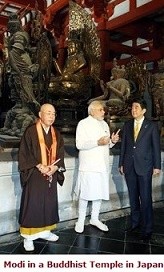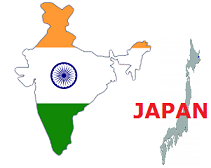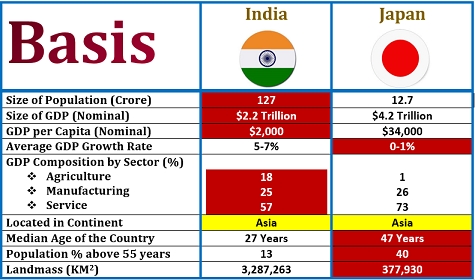As the Japanese Prime Minister Shinzo Abe concluded his 3 days official visit to India, my limited mindset forced me to go a bit dipper into India and Japan relations and with the help of few of my friends, we written an article covering some of the aspects of Indo-Japan relations. There would be two parts of this article while the second part will be there within a few days we hope you would like the first part of the same.
Historical Relations of India & Japan
As everyone knows, India is the most ancient civilization where the mankind incepted, nurtured and excelled. Interesting thing is that our great nation is the birthplace of four major religions of the world namely Hinduism, Buddhism, Jainism and Sikhism. Though Hinduism had been concentrated within India, Buddhism became a global religion and extended to the countries like China, Japan, Taiwan, Korea, Thailand, Vietnam, Sri Lanka, Myanmar etc. As per Wikipedia, “Cultural exchanges between India and Japan began early in the 6th century with the introduction of Buddhism to Japan from India. The Indian monk Bodhisena arrived in Japan in 736 to spread Buddhism and performed eye-opening of the Great Buddha built and would remain in Japan until his death in 760. Buddhism and the intrinsically linked Indian culture had a great impact on Japanese culture, still felt today, and resulted in a natural sense of amiability between the two nations. Sanskrit, a classical language used in Buddhism and Hinduism, is still used by some ancient Chinese priests who immigrated to Japan, and the Siddhaṃ script is still written to this day, despite having passed out of usage in India. It is also thought that the distinctive torii gateways at temples in Japan”. So in short, our relationship with Japan is quite old and strong.

India & Japan- A Comparative Analysis

India is the most ancient civilization as we know, India is also the second most populous nation of the world containing around 127 Crore people, and on the way of becoming the most populous nation within a decade leaving behind China. Japan on the other hand is the land of rising Sun. Means Sun appears first in Japan than anywhere else in the earth. In the increasingly complex world, a deep and strategic relationship between the two nations became the most crucial requirement for both these nations. We tried to have a comparative analysis of India and Japan on some of the very important parameters and following are the results (see the table below).

We can make the following conclusions from the above table:
i. Population of India is 10 times of Japan.
ii. The economic size of Japan is approx. twice of India.
iii. Average Japanese earns 17 times that of an average Indian.
iv. The economic growth rate of India is many times higher that of Japan.
v. Service and manufacturing is the largest components in Japanese Economy while manufacturing is still plays a small role in the Indian Economy.
vi. India is very young nation having the median age of just 27 years & only 13% of the population is above 55 years of age while in Japan, median age is 47 years and over 40% of the population is of 55 years or above.
vii. The landmass of India is about 9 times that of Japan.
Strong and Weak aspects of Japan & India
In this globalized world no country is self-sufficient and has everything in its own. Every country has some of its unique competitive edge over others while lacks in some of the other areas other nations have in plenty. So we decided to look at some of the strong and weak areas of both Japan and India.
Strong and Weak aspects of Japan
As any other ordinary nation, Japan has both strong as well as weak aspects to consider. Some of the strong aspects of Japan are:

Economy: After the Second World War, Japan was the worst affected nation with completely destroyed infrastructure of all types. Factory and industrial network was totally collapsed and two of its major cities of that time was nuked by the United States. However within a period of 30 years, Japan became the 2nd biggest economy of the world only behind the United States. Japan hold this title for many years and recently China taken this from Japan and became the second largest economy. Interesting thing is that for many decades, Japan used to be the only nation the west used to have business relations with. Despite having about no natural resources, ageing population and continuous natural disasters, Japan is the third largest economy of the world. So economy wise Japan seems very promising and India can benefit in many ways from the strong Indo-Japan Partnership.
Per Capita Income: Japan has the third largest economy and population is one tenth of India, hence it has a very high per capita income. The average Japanese earns around 17 times of an average India. This is a whole lot money to have. So the question arises what is the significance of a very high per capita income. Well a high per capita income helps a nation to transform itself from a basic consumer nation to a nation which starts demanding premium and luxury stuffs which then leads the way of innovation and growth as companies continuously works to come out with new and innovative products to satisfy the demand of the consumers. Walkman was innovated by a Japanese Company. This puts a nation in the road of high growths and companies on a high profitability track.
Technology: It is basically technology which has made Japan what it is today. The first bullet train was run in Japan around 50 years ago and Japan is still the home of fastest bullet trains of the world. Japan focused on the education of its population and in the core of that education system was science and technology. Japanese scientists accounts for highest number of Nobel Prize winners from any nation. There was a time when in America there a fear of Japan’s rapid economic and scientific growth and Americans used to think that one day Japanese Companies will buy out entire America. So on technological front Japan can give lot of things to India in various sectors like education, energy, infrastructure etc.
Corporatization: After the recession of 2007 and 2008, capitalism and corporatization became dirty words. But believe it or not, it is capitalism and corporatization which has shaped the modern world. I was reading a book of an American author in which he stated that in today’s America, an average American has a better economic and social life than the richest Americans of 17th century. So this change happened due to corporates and companies. All those nations which has delayed or suppressed the natural process of capitalism and corporatization has paid a huge price. India is an example. After America, Japan is the most corporatized nation and there is no surprised that after American companies, it is Japanese Companies who rules the world. India is also learning this lesson but in the hard way.
Now we will look at some of the weak aspects of Japan
Ageing Population: This is perhaps the worst nightmare of Japan that the population of Japan is getting older day by day. As we can see from the table of comparative analysis that the median age of Japan is around 47 years and approx. 40% of the Japanese population is at or above 55 years of age. The issues with ageing population could be like slow innovations, no or very little entrepreneurship capability, the tendency of playing safe and lack of adventurism in mindset. The ageing population becomes a liability for the earning group of population and which might lead to increase in national debt burden.
Lack of Natural Resources: This is true that having abundant natural resource does not make a nation rich and its citizens wealthy and examples could be Brazil and other Latin American Nations. However a good amount of natural resources reduces the dependence of the country to other raw material producing countries thereby makes the country less vulnerable to the changes in global political scenario. It is to be noted that America used to buy most of its crude requirements from the Middle East therefor America had to keep a very strong influence in the Middle East. However as America is producing more oil internally, the interest of America is reducing in the Middle East day by day.
Low Population Growth Rate: Having a very high population growth rate rarely helps any country to advance but in Japan the rate of growth in population is very low or even negative in some of the years. The low growth rate of population brings less new addition into the society as well as the gap of young and old generation becomes much wider. Japan is often regarded as oldest country of the world not because it has very high life expectancy of around 80 years but because a very low rate of new born children. This is not a good thing for the long term growth of any economy.
Strong and Weak aspects of India
As any other ordinary nation, India too has both strong as well as weak aspects to consider. Some of the strong aspects of India are:

Population Size: Now some of you might have very strong contention against this that population size is a strong point of India, but a wise man always finds opportunities in every challenge. The current population size of India stands at 127 Crores and growing very rapidly. India is expected to bypass China as the largest population country within a decade. This very large population size has some unique features like a very big market particularly for public transportation, food products, Fast Moving Consumer Goods and small durable goods. This population size has another big advantage like mass availability of both skilled and unskilled labors. Now if India can make its population as skilled and productive like Germans or Americans or even Japanese, it will create wonders for Mankind.
Population Age: Our Prime Minister has repeated this many times both in India as well as foreign soils that India is the youngest country of the world and will become the one stop destination for providing the labour force in the 21st century. The median age of India is just 27 years and only 13% of its population is 55 years or more aged. This highly young population needs housing, automobile and lot of other things thus leads to higher economic activities. On this basis India is projected to be third largest as well as on some parameters, second largest economy by 2050. So a young population base is a unique advantage of India but only in that situation when it has been directed properly.
Landmass: India is not the largest country of the world and the countries like Russia, China, Canada, United States, Brazil, Australia etc. are many times bigger than India. However when compared to Japan, India is bigger, lot bigger. The landmass of India is 9 times that of Japan and with a young population base, India becomes very suitable nation for heavy industries like automobiles, electronic equipment’s, aviation parts and components etc. India therefore provides the most suitable alternate of China as far as heavy industries are concerned.
Tech Savvy: Indians are highly sophisticated and very much addicted to technology. India is the second biggest market for most of the American Internet Companies like Facebook, Google and its allied products, Yahoo etc. India is the biggest market for Facebook owned group chat service WhatsApp. India has also the second largest active mobile subscription in the world. Not only in software department, India is one of the largest user of IT hardware’s like Computers, Mobile Phones, Printers, Scanners, Tablets etc. So these things are enough to prove that India is a tech savvy nation. Being a tech savvy country, India has several competitive advantage over others like quick adaptability to latest technologies, less resistant to change, a broader mindset, better command on English language etc.
Now we will look at some of the weak aspects of India
Economy & Per Capita Income: This is perhaps the biggest dent in the global image of India that as far as Economy is concerned, India appears very small. Though the economic growth rate averaged 3-4% since independence, but a nominal GDP of only 2 trillion dollar for the country having the size and population like India is, sorry but, shameful. The per capita income of India stand among lowest in the world tally and is not growing with the pace at what an optimistic person might want. So there is a dire need of significant coordinated efforts India has to do in this regard.
Technology & Innovation: Just above we discussed that India is a very tech savvy nation, problem is that we are a user or consumer of technology, but we are not a developer or creator of technology. So you may ask what is wrong in that. Issue is that country like India which has become addicted to borrowed technology might never create a technology of global standard of its own. As we all know that technology is changing with each passing movement, it is nearly impossible for any Indian company to come up with something more advanced and organised than Apple’s IPhone 6s. Not only that, it will become more difficult next year as Apple might come up with a more advanced version of IPhone. The same principle works in every field. India is least innovative nation and sorry but I do not remember anything that we can claim that we invented since independence. So this is a very weak aspect of India.
Corporatization: As we discussed earlier that Corporatization is a strength for Japan, the lack of it is a serious challenge for India. Since independence, our politicians never promoted or even suppressed the concept of capitalism and corporations and there might be reasons for this like though it is sad but India has a long and painful history of exploitation where rich and powerful always exploited the poor masses. So whatever may be the reason, thing is lack or corporate culture and a strong corporate base is posing grave threats for India as these situation makes a country a permanent debtor to other countries.
So we saw both the strong and weak aspects of both Japan and India. We do acknowledge that our listing might be enhanced in both direction. As being the part 1, we will limit us till here. In the next part we will cover the areas like:
• Japan in India
• Japan & India in Modi’s Era
• Chinese fear factor in Japan and India
• Opportunities for Chartered Accountants
Disclaimer: We would like to point out that this article is our original work including the data and comparative tables. We have sourced data from the websites like Wikipedia, Economic Times and Times of India. We would also like to acknowledge the efforts of CA. Atul Agarwal and Mr. Sumit Ghiria for the compilation of data and creation of tables. You can always write your comments and feedbacks at casaketghiria@gmail.com.








 CAclubindia
CAclubindia

